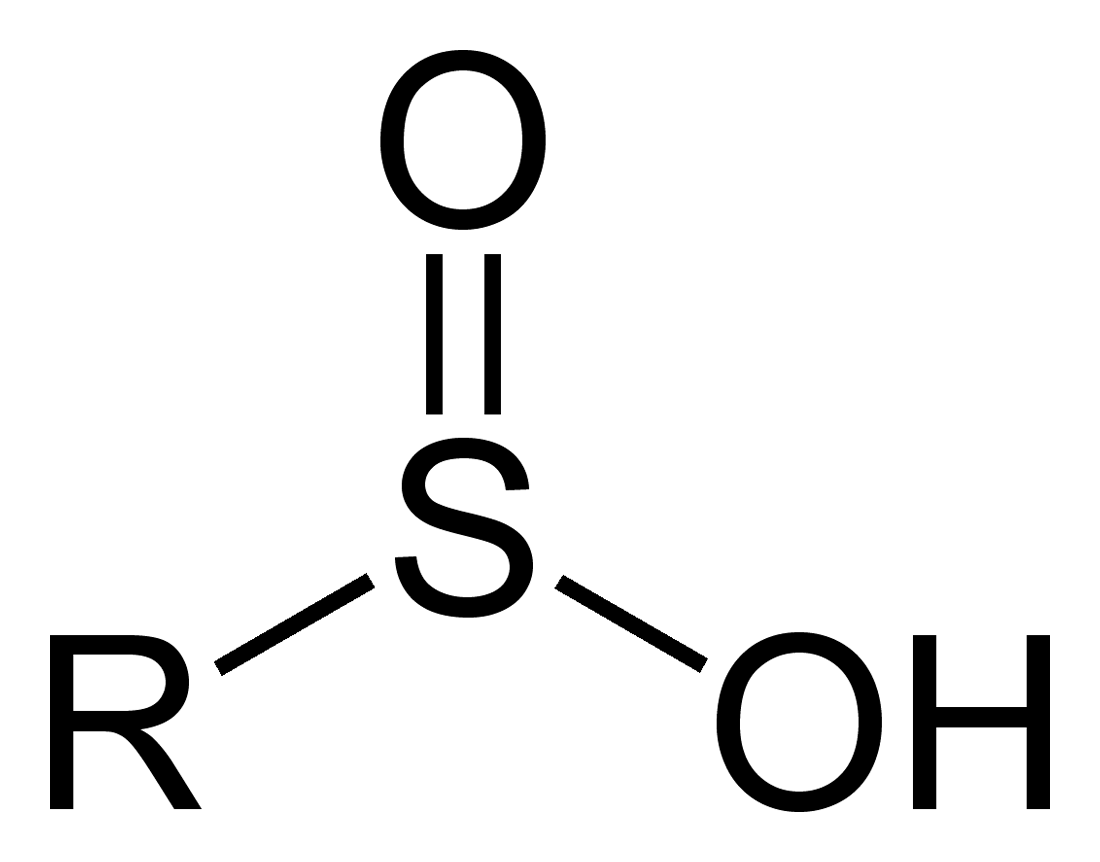Sulfinic acid
Class of chemical compounds From Wikipedia, the free encyclopedia
Sulfinic acids are oxoacids of sulfur with the structure RSO(OH). In these organosulfur compounds, sulfur is pyramidal.[1]

Structure and properties
Sulfinic acids RSO2H are typically more acidic than the corresponding carboxylic acid RCO2H.[2][3] Sulfur is pyramidal, consequently sulfinic acids are chiral. The free acids are typically unstable, disproportionating to the sulfonic acid RSO3H and thiosulfonate RSSO2R.[4]: 679 The formal anhydride of a sulfinic acid has not joining oxygen atom, but is instead a sulfinyl sulfone (R–S+(–O−)–S2+(–O−)2–R′),[5] and disproportionation is believed to occur through the free-radical fission of this intermediate.[6]
Alkylation of sulfinic acids can give either sulfones or sulfinate esters, depending on the solvent and reagent. Strongly polarized reactants (e.g. trimethyloxonium tetrafluoroborate) give esters, whereas relatively unpolarized reactants (e.g. an alkyl halide or enone) give sulfones.[4]: 682 Sulfinates react with Grignard reagents to give sulfoxides, and undergo a variant of the Claisen condensation towards the same end.[4]: 686
Cobalt(III) salts can oxidize sulfinic acids to disulfones, although yields are only 30–50%.[7]
Preparation
Summarize
Perspective
Sulfinic acids are often prepared in situ by acidification of the corresponding sulfinate salts, which are typically more robust than the acid. These salts are generated by reduction of sulfonyl chlorides with metals,[8] although thiolates also reduce sulfonate thioesters to a sulfinate and a disulfide.[4]: 681
An alternative route is the reaction of Grignard reagents with sulfur dioxide. Transition metal sulfinates are also generated by insertion of sulfur dioxide into metal alkyls, a reaction that may proceed via a metal sulfur dioxide complex.
Sulfones may eliminate in base, particularly if a strong nucleophile is present; thus for example sodium cyanide causes bis(2‑butanone-4‑yl) sulfone to split into levulinonitrile and 3‑oxobutane 1‑sulfinic acid:[4]: 681
- SO2((CH2)2Ac)2 + NaCN → NaSO2(CH2)2Ac + NC(CH2)2Ac
The nitrile presumably forms through conjugate addition of cyanide to the corresponding enone.
Friedel-Crafts addition of thionyl chloride to an alkene gives an α‑chloro sulfinyl chloride, typically complexed to a Lewis acid. Likewise a carbanion can attack thionyl chloride to give a sulfinyl chloride. Careful hydrolysis then gives a sulfinic acid.[4]: 682, 684 Sulfinyl chlorides attack sulfinates to give sulfinyl sulfones (sulfinic anhydrides).[5]
Unsubstituted sulfinic acid, when R is the hydrogen atom, is a higher energy isomer of sulfoxylic acid, both of which are unstable.
Examples
Sulfinic Acids and Derivatives
- thiourea dioxide, a reducing agent used in textiles
- hypotaurine, a biosynthetic intermediate
- Rongalite, a source of "SO22−"
An example of a simple, well-studied sulfinic acid is phenylsulfinic acid. A commercially important sulfinic acid is thiourea dioxide, which is prepared by the oxidation of thiourea with hydrogen peroxide.[4]
- (NH2)2CS + 2H2O2 → (NH)(NH2)CSO2H + 2H2O
Another commercially important sulfinic acid is hydroxymethyl sulfinic acid, which is usually employed as its sodium salt (HOCH2SO2Na). Called Rongalite, this anion is also commercially useful as a reducing agent.
Sulfinates
The conjugate base of a sulfinic acid is a sulfinate anion. The enzyme cysteine dioxygenase converts cysteine into the corresponding sulfinate. One product of this catabolic reaction is the sulfinic acid hypotaurine. Sulfinite also describes esters of sulfinic acid. Cyclic sulfinite esters are called sultines.
References
External links
Wikiwand - on
Seamless Wikipedia browsing. On steroids.



